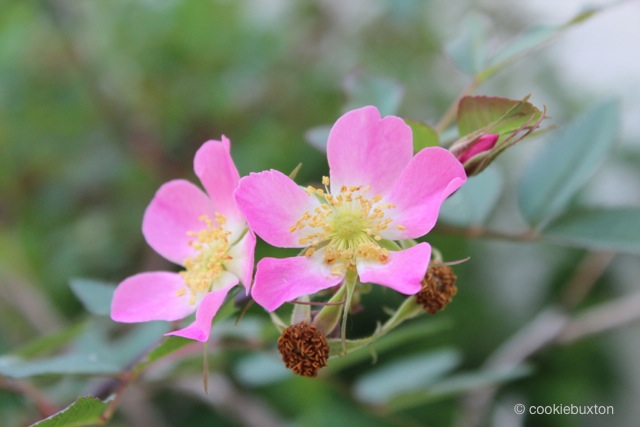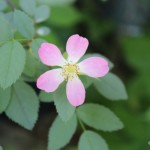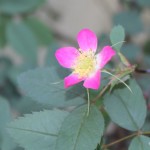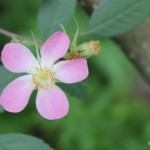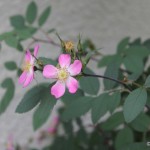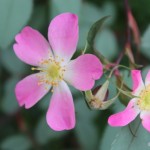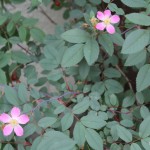Rosa glauca, the Red-leaf Rose
The species rose Rosa glauca (formerly Rosa rubrifolia), called the Red-leaf Rose, is known for its beautiful leaves as well as its small and lovely one-time blossoms in spring. The Rosa glauca blossom is open and somewhat flat, with five small, light pink-mauve petals fading to white near the centre. The yellow stamens add a deeper pop of colour in the eye of the rose.
Native to the more mountainous areas of Europe and introduced in North America by European settlers, Rosa glauca has self-seeded and naturalized here and is often thought to be a local species. It is hardy in Zone 2 (and through Zone 9), which makes it an ideal option for northern gardeners in North America. Here on the prairies, the rose does just fine in the local clay soil.
Rosa glauca is known as much for its “red-leaf” features, which have a bit of blue tone to them, as for its delicate pink blossoms. Perhaps it is because my shrub is not currently a heavy producer of blossoms that each flower is so delightful to me. Originally located in full sun, my Rose glauca has become stingier in its rose production lately. It has gradually produced fewer blossoms each year as the exuberant pink lilac tree growing next to it has grown in size.
Beyond the first blush of pink in spring, when lightly scented flowers decorate the face of the shrub, the Rose glauca is valued equally as much for its beautiful reddish-purple leaves and red-purple shoots and its red rose hips that appear in fall. I am particularly fond of the rose-hips stage. The large and attractive hips cling to the branches through autumn and serve as a valuable food source for birds in the cold months of winter. There is an interesting article on native and naturalized rose species on Dave’s Garden blog written by Gloria Cole that gives an historical perspective around the use of rose hips for nutrition support in Britain during the World War II in place of citrus fruits.
Rosa glauca matures to a medium-size shrub of 1.5 to 1.8 metres in height (5 to 6 feet in my region, perhaps taller elsewhere). I find myself looking across its top branches several times daily during the summer months, as I come alongside it to get water from my rain barrel. True, it’s not ideal to locate a rain barrel next to a shrub rose, but Rosa glauca is lightly thorn-bearing, and so gives very little grief to the gardener even in a small yard. This shrub, however, is often used as a hedge. Grouped in that way, the shrub is sufficiently thorny to give the wanderer a moment’s hesitation before pushing through.
There is something to be said for making room for a species rose or two in city garden plans. This helps, first of all, to achieve natural garden diversity that is good, one would guess, for the eco-system. While I have not seen articles pointing to this species roses being in need of protection at this time, I do feel that home gardeners should intentionally watch for opportunities to fold native or welcomed naturalized species plants in alongside cultivated plants in their home gardens to help ensure plant diversity and preservation of future breeding stock. We rely on our garden associations to keep a watchful eye, but the individual has a role to play as well.
The Rosa glauca in my yard, about 16 years old, has been relatively disease free though it has been weakened a bit lately. While Rosa glauca does reasonably well in shade, there are likely some water issues as the nearby lilac tree pulls more moisture from that area. I am protecting two baby self-seeded volunteers in separate locations in order to duplicate the parent shrub in due course in other locations.
Lois Hole’s Rose Favorites, mentioned on Cookie Buxton’s Top Shelf, includes a one-page write-up on the handsome Red-leaf Rose (p142).
Copyright: NK/cookiebuxton
Photographs and Text: NK
Location: NK home garden
Photograph Gallery
Click on any photograph to enlarge, and then click on that image to advance through the series.
